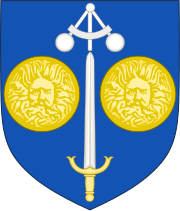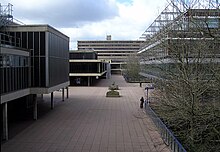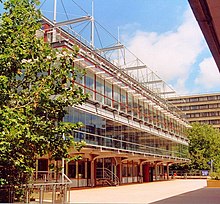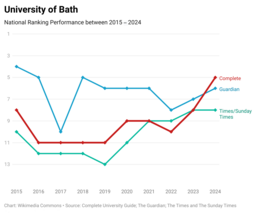
Manchester Metropolitan University (MMU) is located in the centre of Manchester, England. The university has over 40,000 students and over 4,000 members of staff. It is home to four faculties and is one of the largest universities in the UK, measured by the size of its student population in 2020/21.

The University of Bristol is a red brick Russell Group research university in Bristol, England. It received its royal charter in 1909, although it can trace its roots to a Merchant Venturers' school founded in 1595, and University College, Bristol, which had been in existence since 1876.

The University of Surrey is a public research university in Guildford, Surrey, England. The university received its royal charter in 1966, along with a number of other institutions following recommendations in the Robbins Report. The institution was previously known as Battersea College of Technology and was located in Battersea Park, London. Its roots however, go back to Battersea Polytechnic Institute, founded in 1891 to provide further and higher education in London, including its poorer inhabitants.

The University of Leeds is a public research university in Leeds, West Yorkshire, England. It was established in 1874 as the Yorkshire College of Science. In 1884 it merged with the Leeds School of Medicine and was renamed Yorkshire College. It became part of the federal Victoria University in 1887, joining Owens College and University College Liverpool. In 1904 a royal charter was granted to the University of Leeds by King Edward VII.
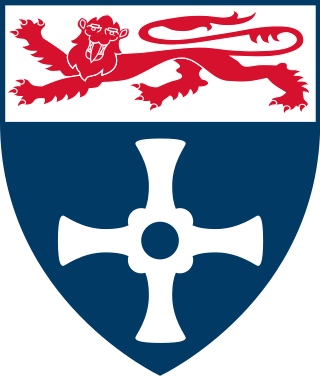
Newcastle University is a public research university based in Newcastle upon Tyne, North East England. It has overseas campuses in Singapore and Malaysia. The university is a red brick university and a member of the Russell Group, an association of research-intensive UK universities.

The University of the West of England is a public research university, located in and around Bristol, England, UK. With more than 39,912 students and 4,300 staff, it is the largest provider of higher education in the South West of England.
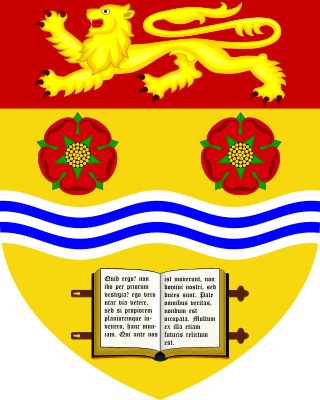
Lancaster University is a public research university in Lancaster, Lancashire, England. The university was established in 1964 by royal charter, as one of several new universities created in the 1960s.

Loughborough University is a public research university in the market town of Loughborough, Leicestershire, England. It has been a university since 1966, but it dates back to 1909, when Loughborough Technical Institute began with a focus on skills directly applicable in the wider world. In March 2013, the university announced it had bought the former broadcast centre at the Queen Elizabeth Olympic Park as a second campus. The annual income of the institution for 2022–23 was £369.1 million, of which £48.3 million was from research grants and contracts, with an expenditure of £339.1 million.
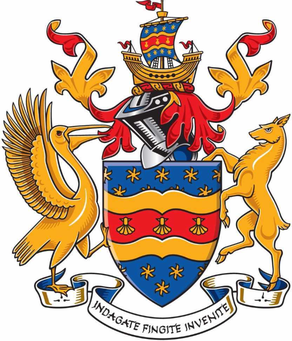
The University of Plymouth is a public research university based predominantly in Plymouth, England, where the main campus is located, but the university has campuses and affiliated colleges across South West England. With 18,410 students, it is the 57th largest in the United Kingdom by total number of students.

Oxford Brookes University is a public university in Oxford, England. It is a new university, having received university status through the Further and Higher Education Act 1992. The university was named after its first principal, John Henry Brookes, who played a major role in the development of the institution.
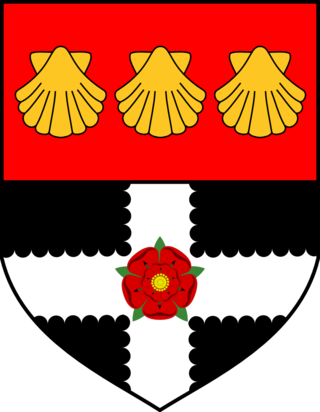
The University of Reading is a public research university in Reading, Berkshire, England. It was founded in 1892 as University College, Reading, a University of Oxford extension college. The institution received the power to grant its own degrees in 1926 by royal charter from King George V and was the only university to receive such a charter between the two world wars. The university is usually categorised as a red brick university, reflecting its original foundation in the 19th century.

The University of Hertfordshire (UH) is a public university in Hertfordshire, United Kingdom. The university is based largely in Hatfield, Hertfordshire. Its antecedent institution, Hatfield Technical College, was founded in 1948 and was identified as one of 25 Colleges of Technology in the United Kingdom in 1959. In 1992, Hatfield Polytechnic was granted university status by the British government and subsequently renamed University of Hertfordshire. It is one of the post-1992 universities.

The University of Wolverhampton is a public university located on four campuses across the West Midlands, Shropshire and Staffordshire in England. The roots of the university lie in the Wolverhampton Tradesmen's and Mechanics' Institute founded in 1827 and the 19th-century growth of the Wolverhampton Free Library (1870), which developed technical, scientific, commercial and general classes. This merged in 1969 with the Municipal School of Art, originally founded in 1851, to form the Wolverhampton Polytechnic.

Glasgow Caledonian University, informally GCU, Caledonian or Caley, is a public university in Glasgow, Scotland. It was formed in 1993 by the merger of The Queen's College, Glasgow and Glasgow Polytechnic. It is located in the Cowcaddens district, just to the immediate north of the city centre, and is Glasgow's third university, after the University of Glasgow and the University of Strathclyde.

Arts University Bournemouth is a further and higher education university based in Poole, England, specialising in art, performance, design, and media. It was formerly known as The Arts University College at Bournemouth and The Arts Institute at Bournemouth and is the home of Bournemouth Film School.
Dame Glynis Marie Breakwell is a British social psychologist, researcher and former Vice-Chancellor of the University of Bath. In January 2014 she was listed in the Science Council's list of '100 leading UK practising scientists'. Her tenure as Vice-Chancellor of the University of Bath was marred by controversy over her remuneration, culminating in her dismissal.

Birmingham Newman University is a public university based in the suburb of Bartley Green in Birmingham, England. The university was founded in 1968 as Newman College of Higher Education. From 2008 to 2013, it was known as Newman University College, gaining full university status in 2013. From 2013 to 2023, it was known as Newman University and Birmingham Newman University in 2023.

The University of Nottingham is a public research university in Nottingham, England. It was founded as University College Nottingham in 1881, and was granted a royal charter in 1948.

The University of Exeter is a research university in the West Country of England, with its main campus in Exeter, Devon. Its predecessor institutions, St Luke's College, Exeter School of Science, Exeter School of Art, and the Camborne School of Mines were established in 1838, 1855, 1863, and 1888 respectively. These institutions later formed the University of Exeter after receiving its royal charter in 1955. In post-nominals, the University of Exeter is abbreviated as Exon., and is the suffix given to honorary and academic degrees from the university.
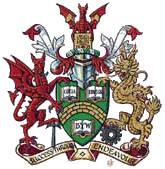
The University of South Wales is a public university in Wales, with campuses in Cardiff, Newport and Pontypridd. It was formed on 11 April 2013 from the merger of the University of Glamorgan and the University of Wales, Newport. The university is the second largest university in Wales in terms of its student numbers, and offers around 500 undergraduate and postgraduate courses. The university has three main faculties across its campuses in South Wales.
